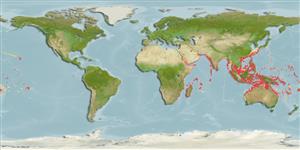>
Eupercaria/misc (Various families in series Eupercaria) >
Lutjanidae (Snappers) > Lutjaninae
Etymology: Lutjanus: Malay, ikan lutjan, name of a fish.
More on author: Cuvier.
Environment: milieu / climate zone / depth range / distribution range
Ecologia
marinhas associadas(os) a recifes; intervalo de profundidade 3 - 150 m (Ref. 9773). Tropical; 35°N - 31°S, 31°E - 145°W (Ref. 55)
Indo-Pacific: East Africa to Tahiti, north to southern Japan, south to Australia.
Comprimento de primeira maturação / Tamanho / Peso / Idade
Maturity: Lm ?, range 37 - ? cm
Max length : 81.1 cm TL macho/indeterminado; (Ref. 132181); common length : 60.0 cm TL macho/indeterminado; (Ref. 5450); peso máx. publicado: 11.0 kg (Ref. 9710)
Espinhos dorsais (total) : 10; Raios dorsais (total) : 15 - 16; Espinhos anais: 3; Raios anais : 8. This species is distinguished by the following characters: body very deep, greatest depth 2.1-2.4 in SL; lips greatly thickened in adults; preopercular notch and knob moderately developed; vomerine tooth patch crescentic, without a medial posterior extension; tongue smooth, no teeth; gill rakers of first gill arch 6 + 11-12 =17-18; caudal fin truncate or slightly emarginate. Colour generally brown with a reddish tinge; each scale on side with a pale
brown border and 2-3 small bluish white spots in central portion; head with numerous undulating blue lines; lips tan; fins largely yellowish to dusky grey-brown; juveniles with a series of 3-8 brown bars on sides and a chalky white spot, with a broad blackish margin, present below anterior soft dorsal-fin rays at level of lateral line, preceded by similar-sized black spot on middle of side (Ref. 9821, 90102).
Occasionally encountered in coral reefs or shallow inshore flats (Ref. 30573). Found singly or in small groups (up to 15 to 20 individuals). Adults on deep coastal slopes; juveniles on shallow algae-reef flats, often near freshwater run-offs (Ref. 48635). Feed on fishes, cephalopods and benthic crustaceans (Ref. 30573). An excellent food fish. In Hong Kong live fish markets (Ref. 27253). Caught with handlines, traps, and gill nets, occasionally trawled; important to artisanal fisheries and marketed mostly fresh (Ref. 9821). Minimum depth reported taken from Ref. 57178.
Ciclo de vida ou comportamento de acasalamento
Maturidade | Reprodução | Desova | Ovos | Fecundidade | Larvas
Allen, G.R., 1985. FAO Species Catalogue. Vol. 6. Snappers of the world. An annotated and illustrated catalogue of lutjanid species known to date. FAO Fish. Synop. 125(6):208 p. Rome: FAO. (Ref. 55)
Status na Lista Vermelha da UICN (Ref. 130435: Version 2024-1)
Ameaça para os humanos
Reports of ciguatera poisoning (Ref. 30298)
Uso pelos humanos
Pescarias: espécies comerciais; Aquacultura: espécies comerciais; peixe esportivo: sim
Ferramentas
Relatórios especiais
Baixar XML
Fontes da internet
Estimates based on models
Preferred temperature (Ref.
123201): 22.5 - 28.2, mean 26.5 °C (based on 353 cells).
Índice de diversidade filogenética (Ref.
82804): PD
50 = 0.5000 [Uniqueness, from 0.5 = low to 2.0 = high].
Bayesian length-weight: a=0.01549 (0.00893 - 0.02686), b=3.02 (2.88 - 3.16), in cm total length, based on LWR estimates for this species & Genus-body shape (Ref.
93245).
Nível Trófico (Ref.
69278): 4.0 ±0.51 se; based on food items.
Resiliência (Ref.
120179): médio(a), tempo mínimo de duplicação da população 1,4 - 4,4 anos (K=0.22).
Fishing Vulnerability (Ref.
59153): High vulnerability (62 of 100).
Nutrients (Ref.
124155): Calcium = 24.1 [15.5, 34.5] mg/100g; Iron = 0.291 [0.189, 0.438] mg/100g; Protein = 18.7 [17.2, 20.0] %; Omega3 = 0.131 [0.093, 0.177] g/100g; Selenium = 74.5 [51.6, 106.8] μg/100g; VitaminA = 110 [21, 389] μg/100g; Zinc = 0.367 [0.300, 0.499] mg/100g (wet weight);
